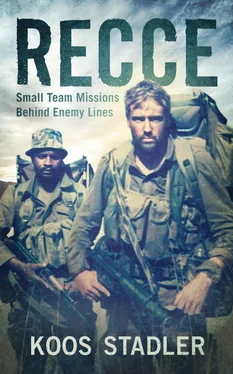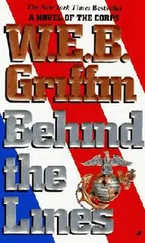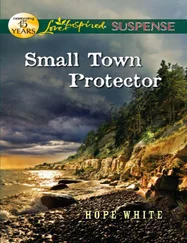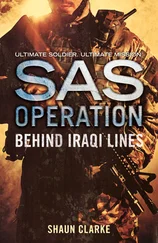Smelling rather than seeing the vegetation, I realised that we were passing a built-up area with bougainvillea along its fence line. It turned out to be a Roman Catholic mission. As we passed a gate in the walled perimeter, Diedies pulled me by the sleeve and handed me the night-vision goggles, indicating that I should look at the wall. The eerie green light of the night-vision equipment revealed a larger-than-life statue of Christ. It was almost like a vision, and the three of us moved off into the night, the image clearly imprinted on our minds.
Before first light we were atop the mountain overlooking Lubango, where we had planned to spend three days watching the area and building up a picture of the target itself, the routine, best infiltration route and escape routes. But we were in for an unexpected and unpleasant surprise: the whole mountain had been stripped of undergrowth, leaving no cover for us. We also discovered smouldering moulds used by the local population for the manufacture of charcoal. What we hadn’t realised from the aerial photos was that the lower brush had been removed to feed the smoking coal ovens. The tree canopy shown in the photos had suggested that it was a thickly vegetated area, but the reality on the ground was vastly different.
We were in trouble. We searched frantically for any kind of cover, but the mountain offered nothing. It was now broad daylight and we had nowhere to hide. Below us we could hear the buzz of the town as it awakened to the new day. In the distance we could see aircraft activity on the airfield. Finally we decided to lie down in a slight depression and wait out the long hours. We covered the kit as best we could. Diedies got up into a tree, while I made myself small between two packs. Da Costa, who had a Cuban peaked cap and FAPLA officer’s insignia, would act as our deception.
Before long we could hear people coming up the mountainside, and soon groups of women and children swarmed across the open terrain in search of more vegetation to destroy. Da Costa and I made ourselves as small as possible, and managed to survive until mid-morning when two women with a string of children in tow walked straight into our hide. Da Costa had no choice but to get up and wave them away. They got such a fright that they dropped their bundles there and then and started running down the mountainside, howling.
This created a stampede, as the children tagged along screaming, not exactly knowing what the threat was. Da Costa ran after them and shouted for them to come back, trying to calm them down. But the damage was done. The whole bunch disappeared down the mountain in the direction of the FAPLA base at the bottom.
It was time for action. If we were caught in the open terrain we would be in serious trouble. We decided to withdraw deeper into the mountain and look for better cover. But first Diedies ordered me to take pictures of the target area from the tree. I climbed the flimsy branches of the tree as high as I could and took a panorama of the airfield and the military bases below. Then we gathered our gear and moved in a westerly direction, taking care not to leave any tracks.
After about two kilometres we came unexpectedly upon a shallow valley with a thickly vegetated river line, where we found a thicket of bamboo reeds to hide in. It was isolated cover, offering no escape routes, but it was the best we could get. We carefully anti-tracked past the thicket and then doglegged back into it. For an hour we kept vigilant watch on our track and listened for signs of a follow-up.
During the morning sched we informed the Tac HQ of our predicament. Boet Swart reacted promptly and sent a message that we should not take the risk, as the odds were clearly against us. However, he asked Diedies to make another sched in the afternoon, as he needed to consult with Pretoria before giving us a final decision.
We considered our situation and weighed up the pros and cons, contemplating whether the enemy would be on the alert and waiting for us. Our instincts told us the job was impossible: we would have to infiltrate a further seven kilometres through a populated area to the airfield, dodging numerous deployments of soldiers to get to our target, and then still penetrate the airfield defences to get to the fighter aircraft. Time would become a critical commodity.
A further challenge, now compounded by the lack of cover on the mountain, was the problem of getting out. We tried to work out a time schedule and a route from the target to the nearest cover. Now that we had seen the target area, we realised that we needed at least two hours under the cover of darkness to get to safety after laying the charges, which meant that we had to finish the job by 03:00 in the morning. This was cutting it fine, as we only intended to penetrate the perimeter by 01:00.
We discussed our options, knowing we could no longer watch the target for a few days as initially planned, because we did not know whether the women had reported us to the enemy or not. Finally we came to the conclusion that we would have to penetrate that night, against all odds. At least we had had a glimpse of the area and would be able to navigate accurately to the point of entry.
In the afternoon, during the final sched, there was a message from the GOC himself, who told Diedies to use his discretion, while reminding him that it was not worthwhile losing an operator, as it would have international consequences. This message increased the pressure on us; responsibility for failure would be placed squarely at our feet.
Finally, late in the afternoon, Diedies called us together again and said, “Hey, guys, there’s only one way. We came here for a reason. What are we waiting for?”
Both Da Costa and I had also made up our minds by that time, and the job was on.
We decided to move the timeline forward to gain a few extra hours. By 16:00 Diedies and I started to prepare our penetration packs. We armed the charges and placed them in their individual pouches. Each of us had a water bag and emergency rations in the central pouch, together with the “Vernon Joynt glue” to stick the charges to the aircraft fuselages. Then we donned our penetration gear: the regular chest webbing with pistol; essential survival gear and emergency kit; Tacbe-499 radio beacons, strobe lights and infrared torches; sheepskin covers for knees and elbows; and night-vision goggles on the chest. I rounded off the picture with an Afro wig as headdress tied to my shirt.
Before last light we cached the packs in the bamboo thicket and made our way to the side of the mountain where we had ascended that morning. Da Costa moved along with a daypack and the HF radio. The plan was that he would stay on the highest point of the mountain closest to the target. He would wait until first light the following morning and then, if he hadn’t heard from us by 06:00, move back into cover. The bamboo thicket would serve as our emergency RV for a full twelve-hour period. At last light the following night Da Costa would start his exfiltration along the E&E route. If nothing had been heard from us by then, the E&E plan would be activated.
We parted quietly, shaking hands and wishing each other well. It was still light enough to maintain a steady pace down the slope. Halfway down the mountain Diedies stopped me and pointed up the mountain to the west. Against the last red light of the setting sun, on the crest of the next mountain ridge, was Christo Rei, the statue of Christ overlooking the town. It was a most striking sight, and, had it not been for the harsh reality of what we were about to do, the view might have been as if from a dream. Looking back at the experiences of that night, it was indeed a significant moment.
We made good time and reached the railway line by 20:00, and then moved along the vehicle track next to it. Once a group of soldiers passed us from the front, but Diedies exchanged some brief greetings with them and they didn’t even bother to stop, obviously in a hurry to get to their destination. It was Saturday night, and we had bargained on some heavy partying among the various deployments of soldiers.
Читать дальше












